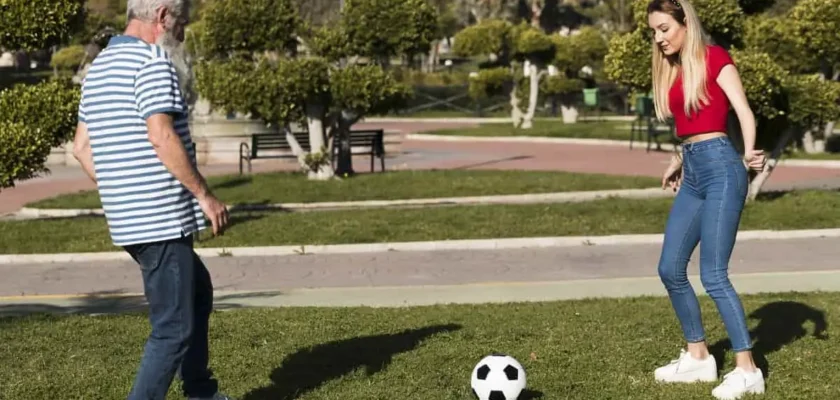As we age, maintaining an active lifestyle becomes crucial—not just for our physical health, but for our mental well-being and social lives too. Engaging in regular physical activity helps to improve cardiovascular health, maintain muscle strength, and enhance overall mobility. Moreover, staying socially active can ward off feelings of loneliness and depression and even improve cognitive function.
What better way to achieve all these benefits than through team sports? Team sports offer older adults the opportunity to stay physically active, socially engaged, and, most importantly, to have fun.
Team Sports for Older Adults
Physical Benefits
Engaging in team sports offers a full-body workout, which can help maintain muscle mass, improve balance, and enhance cardiovascular health. Regular physical activity is known to reduce the risk of chronic illnesses such as heart disease, diabetes, and arthritis.
Mental Benefits
Participating in team sports can boost mental health by reducing stress and anxiety levels. The structured nature of team sports provides a sense of purpose and routine, which can be particularly beneficial for older adults. Additionally, the concentration and strategic thinking required during games help keep the mind sharp.
Social Benefits
Team sports offer a fantastic way to meet new people and foster a sense of community. The camaraderie and team spirit involved in working towards a common goal can create strong social bonds and a support network, which are invaluable for emotional well-being.
Breakdown of 5 Team Sports That Older Adults Will Love
1. Pickleball
Rules and Equipment:
Pickleball is a paddle sport that combines elements of tennis, badminton, and table tennis. It is played with a perforated plastic ball (similar to a wiffle ball) and paddles, on a court that is about one-third the size of a tennis court.
Strategy:
The game emphasizes strategy rather than power. Placement, spin, and shot selection are key elements, making it accessible and enjoyable for older adults.
2. Walking Football
Rules and Equipment:
Walking football is a slower-paced version of traditional football (soccer). The primary rule is that running is not allowed; players must walk.
Strategy:
This sport focuses on skill, positioning, and strategy rather than speed and power, making it a perfect choice for those looking to stay active without the intensity of standard football.
3. Basketball
Rules and Equipment:
Basketball for older adults typically involves playing on half courts with modified rules to reduce the physical strain, such as shorter game durations and smaller team sizes.
Strategy:
The focus is on passing, shooting, and teamwork. It provides a great cardio workout and helps improve hand-eye coordination and agility.
4. Volleyball
Rules and Equipment:
Volleyball can be played indoors or outdoors. For older adults, modifications such as lighter balls and lower nets can make the game more accessible.
Strategy:
Teamwork is essential. The game improves reflexes, balance, and hand-eye coordination. It also offers a full-body workout, engaging multiple muscle groups.
5. Tennis
Rules and Equipment:
Tennis can be played in singles or doubles format. The game requires a racquet and a tennis ball, with rules involving scoring, serving, and volleying.
Strategy:
Tennis promotes agility, balance, and cardiovascular health. Doubles tennis, in particular, emphasizes teamwork and strategy, making it a social and engaging activity.
Read More – In-Home Care Solutions: Disability Support in Arizona
Where to look for Games in Local Areas for Old Adults
Finding Local Teams and Clubs
Many communities offer sports programs specifically tailored for older adults. Local recreation centers, senior centers, and sports clubs often have leagues or drop-in sessions. Websites like Meetup.com or local Facebook groups can also be good resources for finding or forming a team.
Joining Clubs or Starting Your Own Group
If you can’t find an existing team, consider starting your own. Reach out to friends, neighbors, and community members who might be interested. Many clubs are happy to accommodate new teams and can provide equipment and facilities.
Emphasizing Inclusivity and Fun
Remember, the primary goal is to have fun and stay active. Encourage inclusivity by welcoming players of all skill levels and backgrounds. Focus on enjoyment and camaraderie rather than competition.
Conclusion
Incorporating team sports into your routine can offer numerous physical, mental, and social benefits. Whether it’s the strategic gameplay of pickleball, the teamwork in basketball, or the full-body workout of volleyball, there’s a sport out there for everyone. So, why not give it a try? Embrace team sports to stay active, engaged, and youthful at heart.

